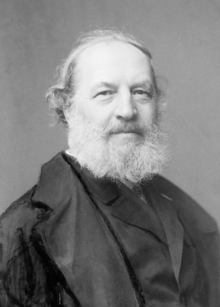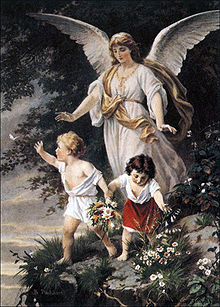Bernhard Plockhorst

Bernhard Plockhorst (born March 2, 1825 in Braunschweig , † May 18, 1907 in Berlin ) was a German painter and graphic artist.
While Plockhorst is only known to experts in Germany today, his depictions of Christ are still very popular in the USA, where they are actively traded as posters and decorate numerous churches and houses.
Life
First, Plockhorst completed a five-year apprenticeship as a lithographer at the Collegium Carolinum in Braunschweig . In Leipzig he came into contact with Piloty, who persuaded him to go to the Academy in Munich for a year, where he also copied Rubens and Titian's pictures at the Alte Pinakothek .
After his time in Munich, Plockhorst moved to Paris in 1853, where he continued his studies under Thomas Couture . Following study trips to Belgium, Holland and Italy, he settled in Berlin, where he painted a series of portraits, but at the same time revealed his talent for religious painting with a large painting ( Mary and John returning from the tomb of Christ ), which he did since then used in the first row.
From 1866 to 1869 he was a professor at the Grand Ducal Saxon Art School Weimar , there a. a. as teacher of the painter Otto Piltz . Then Plockhorst returned to Berlin.
Bernhard Plockhorst died in Berlin in 1907 at the age of 82 and was buried in the Old St. Matthew Cemetery in Schöneberg . In the course of the leveling of the cemetery carried out by the National Socialists in 1938/1939, Plockhorst's remains were reburied in the south-west cemetery in Stahnsdorf near Berlin.
plant
Plockhorst was a representative of the art movement of the Romantic School of the (late) Nazarenes (together with the other religious painters and representatives of the Protestant faith such as Karl Gottfried Pfannschmidt and Heinrich Hofmann ), who, influenced by the Pre-Raphaelites, resorted to art themes from the Middle Ages. At the same time, it also stands for the increasing industrialization and, in some cases, the " kitsch " of Nazarene art.
Religious subjects
In 1862/63 Plockhorst created a picture that was soon to be regarded as his main work: The fight of the archangel Michael with Satan over the body of Moses . It was acquired in 1864 for the Wallraf-Richartz-Museum with funds from the Richartz Fund , but in May 1923 it was auctioned with other paintings from the museum via the Kunsthaus Lempertz . This was followed by an altar painting commissioned by the Prussian Ministry of Culture, the Resurrection of Christ for Marienwerder Cathedral .
Further works showed Christ's farewell to his mother , Christ on the way to Emmaus , Christ appears to Mary Magdalene , Exposure of Moses , Finding of Moses , Let the little children come to me , Luther on Christmas Eve (1887), The adulteress before Christ (Moscow , formerly Galerie Löwenstein). Plockhorst's Guardian Angel with two children on the abyss, exhibited in 1886, was distributed a thousand times as color lithograph and had a great influence on the further development of the popular Guardian Angel pictures .
In 1883 he created the altarpiece with a depiction of Christ for the newly built Immanuelkirche in Berlin.
Stained glass windows based on paintings by Plockhorst adorn several churches in the USA, for example in the Emmanuel Episcopal Church in Shawnee, Oklahoma : The Birth , in the First Congregational Church UCC, Owosso , Michigan: Moses presents Aaron the Ten Commandments on Mount Sinai , in Stanford Memorial Church, Stanford University , California: The Flight into Egypt and in Zion Lutheran Church , Baltimore , Maryland: The Good Shepherd .
His oil painting Noli me tangere experienced a remarkable fate: the painting, which is over 2 m² in size, was originally painted for a German court of law and then sold to England. The first major world exhibition took place in Melbourne in 1880 and Plockhorst's painting was to be exhibited here in the so-called German Court. On the way from England to Australia, however, the transport ship Sorata sank 80 km south of Adelaide. The work could be saved, but it was completely encrusted with a white layer. It looked as if the sea water had broken down the paint particles. In this condition, the picture finally came to the World's Fair, where Professor Rouleaux, who was responsible for the German paintings, sold it to the art dealer Alexander Fletcher (1837–1914) at a ridiculous price. Fletcher brought it to his restorer Peacock. He found out that the white layer came from the plaster residue on the picture frame. Peacock could easily remove them and the intact colors reappeared. Fletcher then sold the restored painting to the National Gallery of Victoria for a handsome price . At that time, the three largest daily newspapers in Melbourne reported in detail about his clever coup.
Portraits
In 1857 Plockhorst created a portrait of the musician Franz Liszt , as well as numerous other portraits of Central German princes, including those of Emperor Wilhelm I and Empress Augusta (Berlin National Gallery) and other important contemporary witnesses, such as the important Leipzig publishers Tauchnitz ("Tauchnitz Editions"), David Hansemann and the children of the Platzmann family. The portrait of the wife of the publisher Spamer, Leipzig, dates from 1859. A life-size portrait of the Leipzig honorary citizen Carl Lampe is in the family's private collection.
Illustrations
As part of the Tauchnitz Editions, Plockhorst drew various title pages and frontispieces , for example for Three Tales for Girls by the English writer Dinah Maria Mulock Craik and for Charlotte M. Yonge The little Duke or Richard the Fearless. Ben Sylvester's Word (1861).
His illustrations for From Bethlehem to Golgotha had far-reaching success . The life of our Lord and Savior Jesus Christ according to the four evangelists by Karl von Gerok (1881), a Danish edition of which appeared in 1882 with a text from CD Wirsén.
For the "new jubilation edition" of Philipp Spitta's Psalter and Harp , he and F. Wanderer created 24 full pictures, the portrait of Spitta, illustrations and 42 initials.
swell
- ^ Hans-Jürgen Mende: Lexicon of Berlin tombs . Haude & Spener, Berlin 2006. pp. 307, 475.
- ^ Auction catalog , lot no.81
- ↑ Caroline Jordan, The Australian Center, The University of Melbourne, Published in The Latrobe Journal, no. 75, Autumn 2005, pp. 77-93 ( online ).
Web links
- Literature by and about Bernhard Plockhorst in the catalog of the German National Library
- Search for Bernhard Plockhorst in the German Digital Library
- Search for Bernhard Plockhorst in the SPK digital portal of the Prussian Cultural Heritage Foundation
| personal data | |
|---|---|
| SURNAME | Plockhorst, Bernhard |
| BRIEF DESCRIPTION | German painter and graphic artist |
| DATE OF BIRTH | March 2, 1825 |
| PLACE OF BIRTH | Braunschweig |
| DATE OF DEATH | May 18, 1907 |
| Place of death | Berlin |

